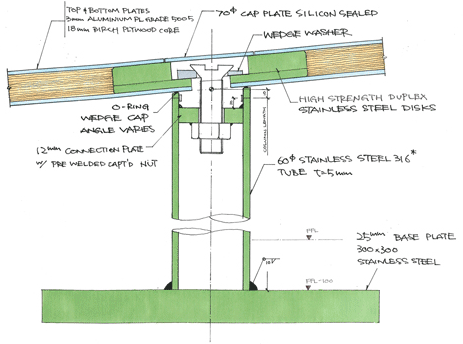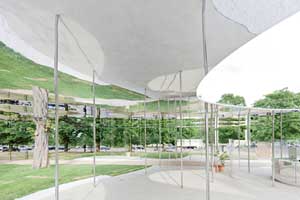Into Thin Air
 |
|
Arup employed advanced analysis software to predict roof deflection and determine placement of columns. Photo: © ARUP |
|
 |
|
 |
The design team created a custom aluminum construction that could be quickly fabricated and easily dismantled and reassembled (above). (Left) The roof rests on 112 steel columns, a combination of 2.36-inch-diameter hollow tubes and 1.57-inch-diameter solid rods. Drawing: ARUP |
Â
Resolving the roof's ultimate form went hand-in-hand with determining the size, number, and arrangement of the columns needed to support it. In the end, two column types were specified. Roughly three quarters of the 112 vertical supports are 2.36-inch-diameter hollow steel tubes. The remaining columns, located in areas that are not as heavily loaded, are 1.57-inch-diameter solid steel rods. Cost issues, time constraints, and limited availability prevented the design team from further minimizing the already super-slender column dimensions. On the other hand, according to Clark, "The differing diameters add variety and richness to the forest of columns."
The columns are anchored 6.5 feet into the ground with screw piles, which, while good at transferring loads, also minimize the amount of concrete and excavation required, and can be easily disassembled by unscrewing them - an advantage for temporary structures. (This year's pavilion has been bought by a private collector.)
Stainless-steel discs within the composite aluminum structure stabilize the connections between the columns and the roof. Aluminum cap plates conceal the joints, creating a smooth, seamless surface. The construction team used a micrometer-controlled countersinking tool - typically reserved for aircraft fuselages - to get the finish as flush as possible. While the roof appears to be a continuous surface, it is made up of 10-foot-tall-by-5-foot-wide panels whose tongued plywood edges interlock with adjacent panels like a jigsaw puzzle. "If you're not pushing boundaries, you're not doing your job," Clark admits. "We essentially developed a new, custom roof system in five months."Â
According to Chermayeff, "We wanted the pavilion to look as though it was floating, as if sometimes it was there, and sometimes not. There is no strong line between it and the park." To that end, the architects "stirred up the borders," as Chermayeff puts it. The curves that define the 4-inch-thick concrete floor do not follow those of the roof above it. To create the required sheltered areas, SANAA used highly transparent, curving acrylic panels similar to the ones they employed for the interiors of New York's Derek Lam Shop [RECORD, September 2009, page 78].
The bending and spiraling form of these panels, too, do not conform to the curving roof lines above, or the concrete floor below. "We did not want to create a sense of enclosure," explains Chermayeff. "There are no doors. The panels are only there to provide some protection against the wind and rain.
The 1-inch-thick panels are buried 1 foot below grade, cantilevering more than 8 feet out from the ground. The panels do not touch the roof, acting completely independently of it. As the roof rises from the ground, the panels' own curving shape maintains the required stiffness, allowing it to support itself.









